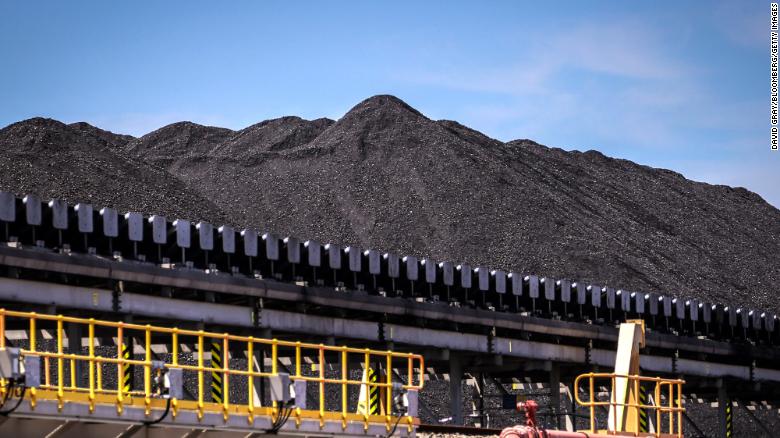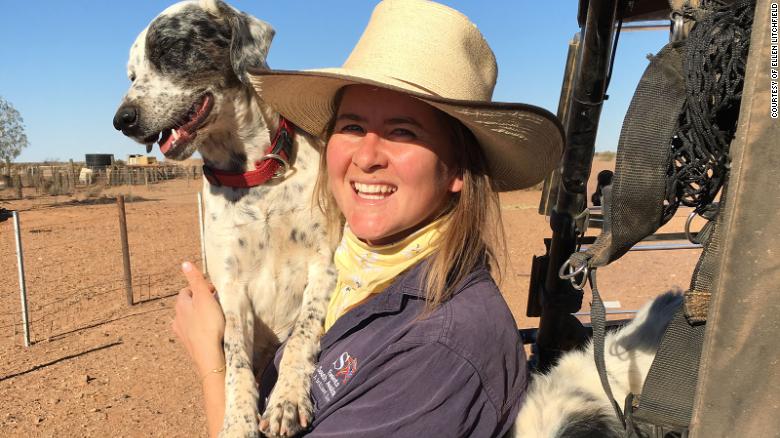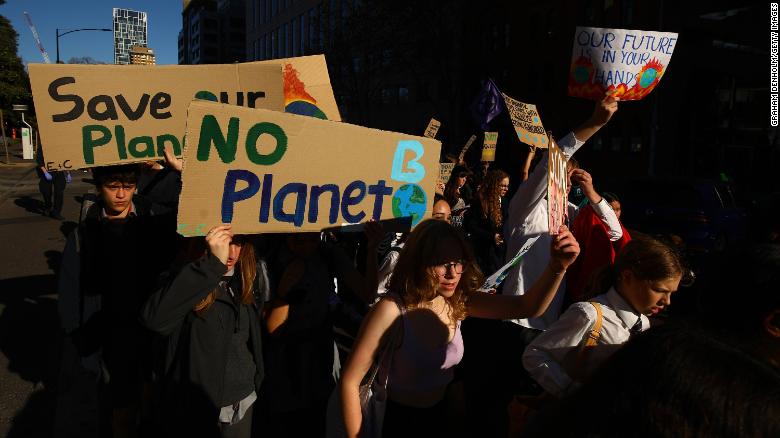Analysis by Ben Westcott, CNN
Updated Fri October 1, 2021

Barnaby Joyce leads Australia's National Party, which traditionally represents rural voters.
(CNN)Australia's Prime Minister has all but confirmed he won't join global leaders at crucial climate talks in Glasgow.
Two more weeks of Covid-19 quarantine would be too much, Scott Morrison said on Friday, claiming that while there are "a lot of international interests," the most important audience for his yet-to-be-unveiled climate plan remains at home.
"My first and most important group that I need to talk to about our plan is not overseas. It's right here in Australia," he said. "It's talking to people in regional Australia, how the deputy prime minister and I believe our plan will help them in their communities, how our plan will help them realize their future."
With that remark, Morrison made it clear his loyalty lies with Deputy Prime Minister Barnaby Joyce, a cowboy hat-wearing, former accountant who leads the National Party, the Liberal government's coalition partner -- and not with international allies who are urging Australia to take greater action to cut emissions.

Australian Prime Minister says Australia will reach net zero "as soon as possible".
Joyce says he wants to see the numbers before he agrees to any new climate targets, as he struggles to unite a party riven with differences over Australia's future relationship with coal.
Morrison's refusal to commit to a target of net zero emissions by 2050 hasn't just isolated him on the international stage. Even within Australia's own borders -- aside from staunch pro-coal Nationals -- Morrison is looking more and more like he's being left behind.
On Friday, even the Minerals Council of Australia, the country's mining advocacy group, announced it supported net zero emissions by 2050. The country's largest states have already announced large emission reduction targets, and surveys also show most Australian people support tougher climate action.
Will Stefan, emeritus professor at the Australian National University's Fenner School of Environment and Society, said public opinion appeared to contradict the interests of Morrison's political allies and big business, who invest heavily in fossil fuels.
"I think there's a growing gulf between what the Australian public wants and how our Prime Minister is behaving," he said.
And that's a dangerous position for a Prime Minister to be in just months before a federal election.

Photovoltaic modules at a solar farm on the outskirts of Gunnedah, New South Wales, Australia.
Selling Kodak cameras
Part of the reason for Morrison's reluctance to take actions lies in the fact that he leads a coalition made up of the center-right, pro-business Liberal Party and the National Party, who traditionally advocate for regional workers and agricultural communities.
The National Party has long opposed any action on climate change, claiming it will hurt rural communities. Joyce wants assurances the party's traditional supporters won't lose out in any broader transition to renewable energy.
"It's the little old bush accountant saying that lots of clients have ideas, but (you need) to sit down with them and say, 'Okay, that's your idea, let's prudently go about this,'" Joyce told told the Australian Broadcasting Corporation (ABC). He said whole towns rely on Australia's coal industry, and they shouldn't be forgotten.
"It's not just those farms, not just the mines, it is the towns that are attached to the commerce of those industries," he said. "It is the hairdressers, the tire business. These people also rely on the Nationals to make sure that we don't pull the economic rug out from underneath them."

Deputy Prime Minister Barnaby Joyce during Question Time in the House of Representatives at Parliament House on June 23 in Canberra, Australia.
While some Nationals support a move to net zero, others seem unlikely to budge, much to the frustration of some of Morrison's Liberal Party colleagues who want greater climate action.
On Sunday, a coal-loving Nationals senator took to Twitter to say he was "deadset against net zero." A Liberal minister hit back, accusing him of "selling Kodak cameras ... when the iPhone is coming."
The divisions are making life difficult for Morrison, who said he's working on a plan to bring his government "together on this issue."
It's not clear when that plan will be released, but he has said it'll be ready before other leaders descend on Glasgow for the 2021 United Nations Climate Change Conference, also known as COP26 as it is the 26th UN conference on climate change.
Despite being one of the largest per capita emitters of carbon in the world, according to the World Bank, the Australian government has dragged its feet on climate change action for decades.

The steelworks and coal loading facility in Port Kembla in Wollongong, Australia.
Australia's pledge to reduce its carbon emissions by 26% to 28% from 2005 levels by 2030 is far below commitments from similar developed nations, including the United States. And Morrison has steadfastly refused to commit to net zero by 2050, saying only the country will reach the goal "as soon as possible."
Morrison's government has insisted that Australia is meeting its climate targets -- and even beating them -- but Stefan said the emission reduction target was "very weak."
Experts have previously said Australia would need to cut its emissions by twice the current commitment, up to 50% by 2050, to keep warming below 2 degrees Celsius worldwide. And even greater cuts are needed to keep warming below the international target of 1.5 degrees Celsius.
"They're talking about new technologies and so on, but they're avoiding, completely avoiding the way we can get our emissions down, rapidly at cost and with side benefits. And that's to go renewable," said Stefan.
Part of the trouble is Australia is heavily reliant on mining for its economic prosperity. The country is one of the world's biggest coal exporters, bringing in around 50 billion Australian dollars ($36 billion) and employing more than 50,000 people, according to the government.

Australia is one of the world's biggest coal exporters.
With coal prices surging, some Nationals see no reason to cut off a lucrative source of revenue.
But the rival argument is that Australia has an opportunity to generate masses of renewable energy and industries to replace jobs lost in fossil fuels.
On Wednesday, as he announced plans to halve the state's emissions by 2030, New South Wales Environment Minister Matt Kean said Australia should "lead the world" on climate change, describing it as the "biggest economic opportunity of our lifetime."
"The reality is that the world is changing rapidly ... We would be absolutely mad to miss it," he said.
What the Australian people want
Some politicians have pitched Australia's climate divide as a city versus country debate that will see the latter lose out.
In an opinion piece published Monday, Nationals Sen. Bridget McKenzie accused her Liberal Party colleagues of forgetting about rural Australians and miners whose jobs would be lost by tough action on climate change.
At a press conference with the Liberal Party's deputy leader, Treasurer Josh Frydenberg, on a separate issue Wednesday, the two traded jabs over the government's climate policies.
When Frydenberg said "climate change has no postcode," McKenzie responded by saying some Liberal Party politicians were trying to be "cool" by pushing for climate action. "Josh isn't one of them," she added.
While politicians argue over the best way forward, rural Australians are getting on with it. They say they have no choice.

Ellen Litchfield, a third-generation farmer, said rural and urban communities have more in common than some politicians seem to think.
With her family, third-generation farmer Ellen Litchfield operates Wilpoorinna, a sheep and cattle station 650 kilometers (400 miles) north of Adelaide in the Australian Outback, making her acutely aware of the threat of droughts to her and farmers like her.
She said the idea that there was a divide between rural and urban voters was mostly cooked up by politicians, capitalizing on a nostalgia for rural Australia, to argue for the status quo.
"I think that there's a lot more in common with the regional voter and the urban voter than they want us to believe," she said.
Litchfield, who advocates for Farmers for Climate Action, said many regional workers see "the benefits of changing."
"Mind the pun, but we're at the coalface of climate change every day. We're working out in the environment, we're seeing how things change," she said.
"And feeling supported and like we are all working together, all the industries are working together to secure the future, would be a huge benefit for us."
It isn't just Litchfield who supports climate change action in Australia.

Protesters take part in the School Strike 4 Climate rally on May 21 in Melbourne, Australia.
A poll by Essential Polling released on August 17 found more than 60% of respondents supported providing greater funding for solar power, introducing a carbon levy on polluters and putting in place a net zero carbon emissions target by 2030.
ANU professor Stefan said government efforts to reduce emissions in some jurisdictions, such as his home in the nation's capital, Canberra, had been popular with the electorate.
"This is a global problem, and we're all expected to do our fair share," he said.
Whether Morrison can come up with a plan to balance the competing forces in his coalition remains to be seen.
But whatever compromise he can offer will be pored over at length by the international community -- and by all Australians with votes to cast the next election.
CNN's Hilary Whiteman contributed to this report.


















